Welcome to the week. Here are the most notable items BikePortland editors and readers came across in the past seven days:
 Wait! Before we dive in… Please learn about and consider supporting this week’s sponsor, Willamette Valley Cyclists, as they work with build a pump track and other places to ride in Wilsonville!
Wait! Before we dive in… Please learn about and consider supporting this week’s sponsor, Willamette Valley Cyclists, as they work with build a pump track and other places to ride in Wilsonville!
Walking while brown: Nearly 90% of the tickets written by the NYPD for walking against a light or crossing a street mid-block were given to black or Hispanic people. And that’s just the start of the stats that show “jaywalking” laws are enforced unfairly.
Moab trails under threat: The Trump Administration is allowing oil and gas companies to consider drilling at Moab’s famous Slickrock Trail, but bike industry groups are already pushing back.
Spineless mayors: Good news: Majority of U.S. mayors realize that drivers and their cars are ruining cities. Bad news: They lack the courage to do much about it.
LeBron bikes: Basketball star LeBron James worked with Lyft to give free bike share memberships to Harlem teenagers and told Streetsblog the kids need safer places to ride them.
Winter biking: I know it’s relatively nice outside right now, but you might want to file away this story from Chicago about biking through a cold and snowy winter.
Advertisement
Local Focus
Climate injustice: A new study from PSU found that the “heat island” effect is worse in parts of our city that are most heavily impacted by racist housing and land-use policies of the past.
Pioneer mechanic: Sellwood Cycle Repair and Team S&M’s Brenna Wrye-Simpson is the only female mechanic on the UCI Cyclocross World Cup circuit.
Bridge of life: Because ODOT’s Highway 99W through Sherwood is so dangerous and impassable by humans not in cars, local leaders are pushing for a new walking/rolling bridge to connect a school and other community destinations.
Real transit talk: With a major investment in bus service part of Metro’s bid for a transportation funding measure, Willamette Week talked to people who rely on the Line 72 bus to find out what riders really want.
Vancouver’s deadly road: The stretch of 112th Avenue in east Vancouver where two young people were hit and killed by a driver last week is dangerous by design and has a long history of tragedy.
— Jonathan Maus: (503) 706-8804, @jonathan_maus on Twitter and jonathan@bikeportland.org
— Get our headlines delivered to your inbox.
— Support this independent community media outlet with a one-time contribution or monthly subscription.


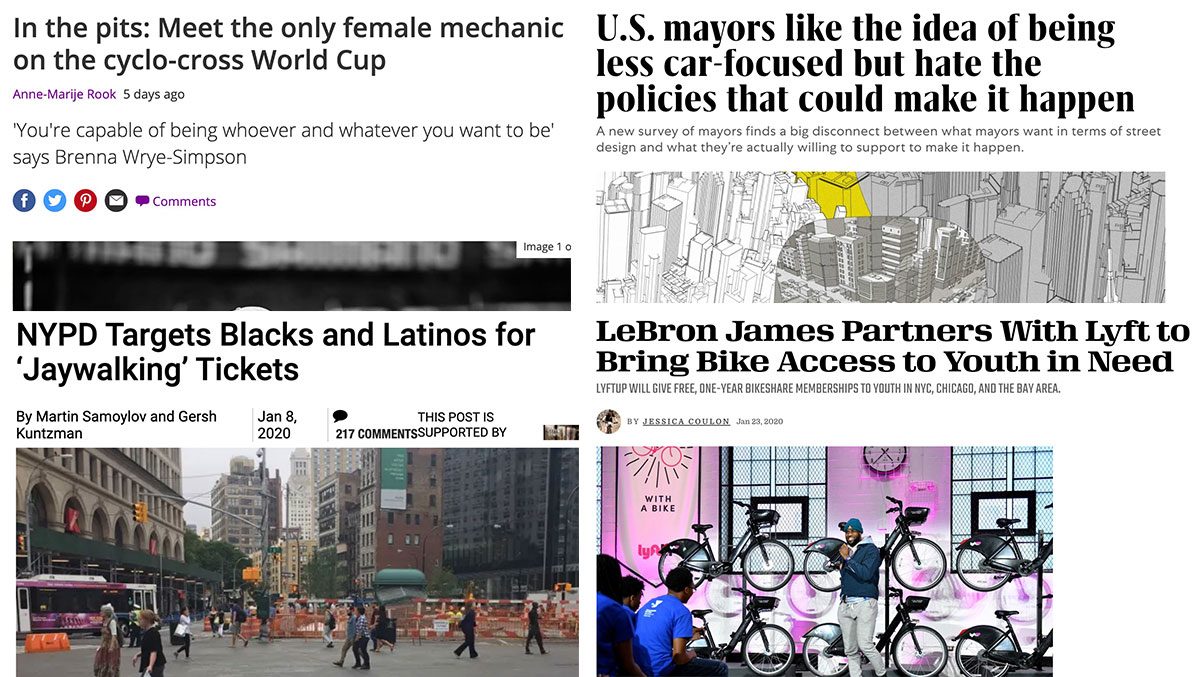
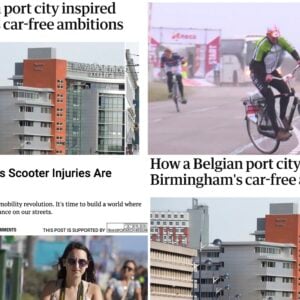
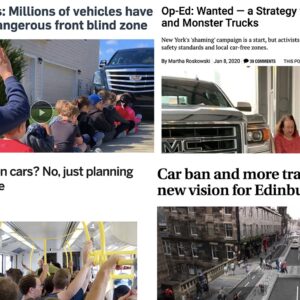
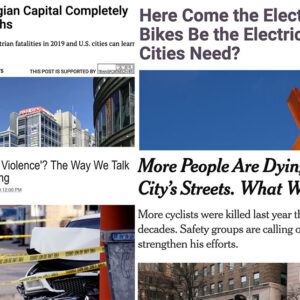
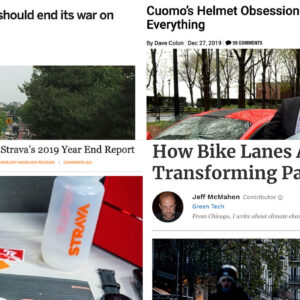
Thanks for reading.
BikePortland has served this community with independent community journalism since 2005. We rely on subscriptions from readers like you to survive. Your financial support is vital in keeping this valuable resource alive and well.
Please subscribe today to strengthen and expand our work.
Spineless mayors article: “Jackson, Wyoming, has about 27.1 parking spots per household.“
What to say?!
Jackson is a tourist town so many of those cars are coming from elsewhere. Not households in town.
aka, Jackson Hole, next to the Grand Tetons, south of Yellowstone. Google says 2.6 million visitors a year.
Yeah the Jackson thing is to accommodate all the tourists that constantly fill the town. I lived there for a summer and biked a lot because it was convenient, and also the only way to find parking “downtown” for running errands. The population of the town is so low because development is constrained by park/forest land and the super rich. The billionaires are driving the millionaires out of Jackson, and the firefighters and police all live an hour away.
I was in Leavenworth the other weekend and was reminded of Jackson. Tons of parking spots, all filled with cars, and lines of traffic everywhere as people hunt for a spot. Kinda crazy. It’s the type of place where you realize they really need to build a parking garage on the edge of town and then go pedestrian mall and close the streets to cars in the main town square area.
Google says Leavenworth gets about 2 million visitors a year…
Parking is to the (early) 21sr Century what smoking was to the (late) 20th Century.
What’s vaping? Lyft?
Vancouver and Sherwood are two examples of communities that have to be dragged kicking and screaming to care about the lives of anyone not driving. I would suggest for both towns, speed traps and brutally high speeding fines specifically to raise the money for pedestrian improvements. I dare anyone in Clark County or Vancouver government, specifically, to tell me with a straight face that they have any regard for non drivers’ lives–they demonstrably do not.
On this website of all place, we should not be using the misnomer “speed trap.” All we are expecting people to do is follow the law.
A “speed trap” is different; it’s a deliberate engineering of circumstances with the goal of getting people to violate the law so they can be fined. It is different than rigorously enforcing speeding laws.
I used to subscribe to Car & Driver, but I have never heard of such a situation. C&D would regularly publish articles about jurisdictions that they described as “speed traps,” but there was not a single case that they could point to where this was anything other than a rigorous enforcement of the law. In a typical situation, they would describe a small town in Ohio where the speed limit on main street is 25 mph, and the town would find drivers how exceeded that speed. Even C&D had to admit that the speed limit was always clearly marked as drivers entered the town, but too many people chose to ignore the speed limit despite driving through the town center. Law enforcement, far from being too rigorous, was actually not rigorous enough because motorists’ driver’s licenses would not be suspended even if they had accumulated more than one such violation. The law needs to be much stricter: if you get caught driving 40 in a 25, the first time it should be a ticket; if you get caught again, your license needs to be suspended.
You’re exactly right, and the ‘speed trap’ nonsense is simply evidence of delusional Car Head.
Enjoy: https://www.speedtrap.org/
Ah, not surprised to see that site is sponsored by the NMA
I’m not going to define them as a “trap” because speed zones are always marked, and believe in vigorous enforcement, and that the following method of setting speed limits has some serious flaws, but in California there can be “illegal” speed enforcement. If you’ve ever driven or ridden CA roads you’re probably very familiar with the speed measuring tubes/cords/wires things across lanes. They don’t track individual vehicles other than adding their speed to a tally over a few weeks period to learn the average speed drivers are driving at.
State law says that the speed limit for that section of road cannot be set lower than the 85th percentile speed average from the survey. If a jurisdiction chooses to set the limit lower for any reason it loses the ability to enforce those limits using radar or laser measurement and can only use old-school pacing in a police vehicle. Tickets issued by remote speed measurement are routinely tossed-out if the individual can research and find the most recent survey is out-of-date as well, something probably a lot of cash-strapped municipalities let slide.
It was expected that people would reach a psychological limit to what they felt was “safe” at which point limits would be relatively static. And even with it being a little illogical to let speeding drivers set the limits in the first place, the increase in vehicle horsepower and handling and the rise of the SUV and lower perceived speed due to driver height above the road have continued to push limits to max out at 50-55mph freeway levels on many 2-4 lane arterial boulevard streets. It’s a viscous circle too, because road engineers keep trying to build in a “safety margin” into new roads letting people just keep going faster. With everything else they’re doing wrong, I’m at least thankful ODOT didn’t adopt similar rules.
RE Heat Islands:
>>>
If Portland is going to find its way to a cooler future, the path to get there will need to be lined with trees. … Increasing foliage and green space is the best way to combat the pernicious heat islands, at least in the short term, Shandas said. Trees absorb more heat from the sun and create shade. Plants pull moisture from the ground, which in turn evaporates into the air, providing a cooling effect.
…
The city council is currently debating a plan that would allow apartments and multiplexes in neighborhoods previously zoned only for single-family homes.
<<<
Unfortunately, these two policies are at odds with one another. As we add more density, we necessarily lose more greenspace in our neighborhoods. Luckily, we can always install more air conditioning to deal with the increasing heat islands.
Nesting fault!
Maybe we can paint the AC units green?
I’d recommend greenwash.
it’s easy enough to include street trees when increasing density.
there is also a push for more vegetated roofs in Portland. those aren’t a slam dunk, but done well they can provide some cooling.
The lilliputian street trees that we plant these days hardly compensate for lost green space and larger trees that actually provide a canopy.
With more people, we need more parks and other (literally) green infrastructure. Parking strips won’t cut it.
you’re not wrong, but big street trees are still an option that’s totally compatible with denser development. no need to choose between street trees and larger green spaces. an all of the above approach would be great.
Theoretically an option, yes, on a few streets with very wide parking strips. In practice, I’m not seeing big trees planted anywhere around new RIP-style development. Big trees generally need to be yard trees, which requires a yard or similar open space.
I love riding through neighborhoods with big trees. It’s much more pleasant than riding through urban corridors characterized mainly by concrete.
The new RIP rules (at least the last time I read them) penalize flat-roofed houses by giving them lower height limits than pitched-roof houses, which creates a disincentive to building vegetated roofs.
They also (again the last time I read them) give some incentives to building separate ADUs, vs. putting the unit within the same structure as the other unit or units on the site, which means more of each site covered with buildings and less room for trees or other landscaping.
The whole point of the piece on heat islands was that neighborhoods most affected were in in the outer periphery*. On the other hand, the twee inner Portland neighborhoods that were targeted by “racist old Portland” gentrification are somehow largely unaffected.
*the few areas of PDX that are still barely unaffordable to poor folk — many of whom were displaced from gentrified inner PDX.
“But what can we do, I mean it’s not like we’re the may- oh wait…”
Bridge of Life: all those “busy” pedestrian bridges over East Portland’s super busy and deadly streets should be a dead giveaway that such bridges are a total waste of money – pedestrians and school children simply do not use them. Calming traffic and slowing cars is far more effective and cheaper.
exactly. I once had a very experienced PBOT planner tell me, as we biked under one of those bridges in east portland, “Those bridges are a sign of failure.” He’s right. They’re an admission that drivers are the top priority and that throughput is more important than the quality and safety of people’s lives.
Good point. This will require pedestrians to climb up several stories and walk two football fields, simply to cross the street. ODOT used to build bridges for people to cross rivers, now it builds bridges for people to cross the rivers of swirling, deadly traffic it has created.
My immediate thought when I saw the plans for that new traffic circle out front of the high school was how many roads kids would have to cross to get to school. The school is isolated from the residential part of Sherwood by either Hwy99 or Elwert which itself is obviously going to grow into a huge road as the school and other areas develop. Reminds me of the new Mountainside High School in beaverton school district, build a giant new school on the very edge of the growth boundary and make kids cross gargantuan intersections to get to them (in that case, Scholls Ferry and 175th/Roy Rodgers.
The roundabout made you think of roads kids would have to cross???
Modern roundabouts are very safe intersections for pedestrians.
All modern roundabouts have median islands separating incoming and outgoing auto traffic. Pedestrians don’t have to find a gap in two directions of traffic, just one. This is safer for pedestrians, especially for younger or older ones, because they only need to concentrate on one direction of traffic at a time. This is what is meant by two-phase. Cross the first half, pause if you need to, then cross the second half. With the lower design speed of 15-20 mph, roundabout medians become very safe places to cross. It’s estimated that median refuges for pedestrians reduce crashes by 25% or better.
Have…. have you looked at the specific designs for what we’re talking about?
There’s no safe way to get to Happy Valley Elementary/Middle School without being in a motor vehicle. The surrounding roads have no shoulders and it’s a bunch of suburbanites speeding by in overly huge vehicles.
FYI Jonathan regarding that WVC sponser, looks like the new tracks are proposed in McMinville, not Wilsonville.
The ped bridge at 122nd and Sacramento is especially sad. At least one half of it has become a homeless camp now.
I for one would really appreciate it if you stopped riding your bike on our camping infrastructure.
Real Transit Talk: Great Willy Week article. We’ve been told by our competing transit companies, who together run about 60% of transit in the USA, that the best and most efficient way to make transit get more funding is to get more people to use it – crowded passengers will put more pressure on local governments and taxpayers to pony up more funding. And they also say that the best way to get use go up significantly is to make it far harder and more expensive to drive and park (or use Uber) – adding bus-only lanes is the quickest way, as is introducing a city-wide parking permit program. Seattle is the best example of a city that has seen a rapid ride in ridership by making driving harder and more expensive.
The Oil drilling in Moab story is an important one. As our military adventures for oil in the middle east draw to a close, and the financial ponzi scheme that is the fracking industry crumbles in to insolvency ,oil companies will become increasingly desperate to drill every last little pocket of conventional oil that they can get their hands on. Many important natural areas will come under threat because of this and we need to stand ready to push them back.
“U.S. mayors realize that drivers and their cars are ruining cities.”
The fact that mayors are willing to repeat empty political slogans about cars and the climate crisis is not evidence of any kind of “realization”. Genuine realization requires action.
Bridge of Life: Slightly odd timing for this push as the area is undergoing two massive, long-planned traffic and construction projects. The high school this bridge intends to connect to, and the traffic circle connecting two busy collector streets (Kruger and Elwert) and 99W in front of it are both brand new construction projects. Or rather they’re not even complete yet and road closures in the area are ongoing. Why for Pete’s sake was this bridge not included in funding for the mega-project, or even more critically why doesn’t the design of the new roads improve bike and ped facilities in the entire vicinity so that the surrender bridge is not even necessary in the first place!?
The Wash. Co. project site only offers an unspecific bullet point that there will be “bike and pedestrian improvements”. Probably just formerly no-shoulder roads getting crappy bike lanes (that then as typical fade out at the edge of the project area), and maybe some different traffic light timing. That the safety of the the students actually getting to the school that the whole project revolves around in anything other than a vehicle is apparantly an afterthought and is symptomatic of what’s so wrong with our planning. The county knows it’s dangerous enough for vehicle users that a roundabout is needed to tame the mayhem. But everyone else seems to get some token improvements and a shrug emoji.
https://www.co.washington.or.us/LUT/News/haide_and_elwert_close.cfm
I can’t see why the traffic circle and intersection were even needed to be changed at all. It’s just a complex mess than only enforces the concept of “drive kids to school”. Would have been so simple to realign Elwert to be the main intersecting road with 99 and make Kruger T into it before light. Basically just a re prioritized version of the Y that existed already.
Bridge of life: Can’t read article because it requires a login.
Real transit talk: When leaving the Western Bike Works warehouse sale at BikeTiresDirect/Velotech the kid and I had to walk almost a mile to get to a bus stop. It was NOT a pleasant walk. It was infrastructure designed for cars and it was difficult to navigate by foot. It wasn’t made easier by the event organizers who places illegal signs blocking the sidewalks nearby. Their lack of known bike racks was also an issue. Very few people biked to that bicycle event.
You say Willamette Valley Cyclist are working to build a pumptrack and other places to ride in Wilsonville. It looks like it is in Yamhill County and NOT Wilsonville.